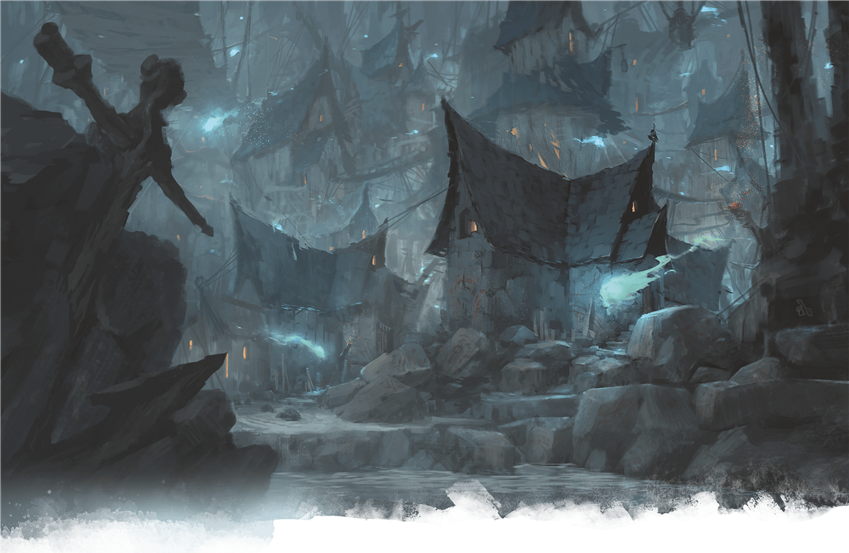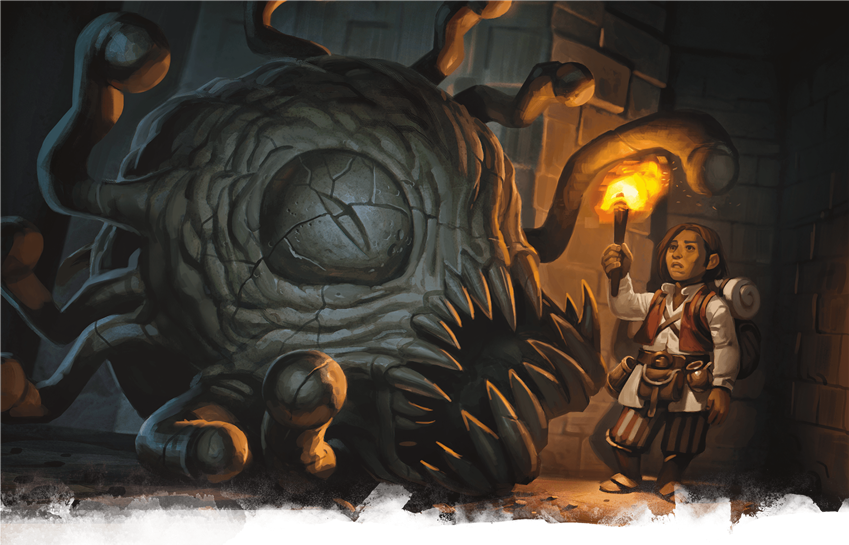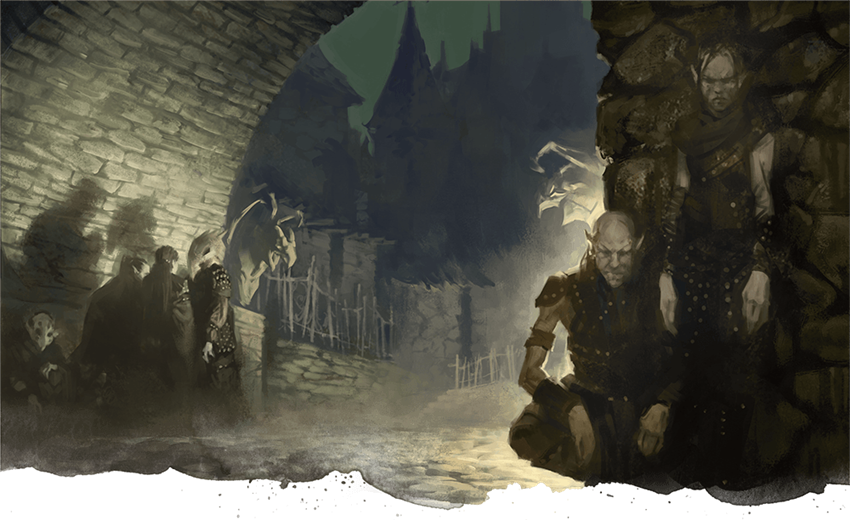This article contains minor spoilers for Waterdeep: Dungeon of the Mad Mage.
Skullport may be the safest city in Undermountain, but it doesn’t have much in the way of competition. More to the point, Skullport is the only city in Undermountain. Its streets are rife with brain-sucking mind flayers, its skies (such as they are) are patrolled by half-mad flameskulls, and its dark alleys are prowled by bugbears, duergar, drow, and all manner of unsavory folk. Still, when you’re an adventurer deep in one of the deadliest dungeons in all of Faerûn, even the dour and dangerous silhouette of Skullport is a welcome sight.
If you’re a Dungeon Master, how can you use Skullport in your Undermountain dungeon crawl? And if you’re a player, why would you want to go to a place so flush with evil?

Dungeon Master’s Perspective: Skullport
Skullport is a place for adventurers to find information. It is a place to sell treasure. It is a place to recover their stamina, to rest, and resupply. It is even a place where they could find adventure by trying to sneak into Xanathar’s Lair (as described in Waterdeep: Dragon Heist). But most importantly, Skullport is a place for you to provide a change of pace.
Undermountain, like all dungeon crawls, requires you to have a strong sense of pacing. You need to know how to present the characters with challenges that are more than just combat after combat after combat. This is creatively exhausting, because Dungeon of the Mad Mage isn’t an adventure, per se. It doesn’t have story beats or a strong overarching plotline or a ticking clock. It’s a dungeon. It’s a location. It’s a toolkit. And you have to use these tools to create an adventure. It’s “DIY D&D,” to steal a phrase.
This can be challenging if it’s your first time doing this whole megadungeon thing. Fortunately, Skullport gives you a chance to break up the action. It’s a difference in kind. It’s a return to the intrigue of Waterdeep: Dragon Heist, even if it’s just for a fraction of dungeon level. Skullport’s description in Dungeon of the Mad Mage isn’t nearly as robust as Waterdeep’s description in Dragon Heist, but by this point in your Undermountain experience you should know at least a thing or two about improvising scenes, characters, and combats from scant information.
It also provides you with a location to introduce new player characters who are eager to adventure deeper into Undermountain, and to give your players a place to sell treasure, purchase potions, and so forth. These functions can all be served by the Yawning Portal as well, but I would encourage you to try limiting your players’ access to Waterdeep a little bit. Don’t tell them they can’t go back up, that would be unfair. Instead, create consequences for taking the time to leave the dungeon. Previously cleared dungeon levels could be filled with new monsters and new traps. This isn’t like a video game where cleared dungeons are cleared forever; it’s a thriving ecosystem of monsters, thieves, and wild magic.
Player’s Perspective: Skullport
In The Hobbit, Gandalf referred to Rivendell as “the Last Homely House,” beyond whose safe valley lay only the wilderness of Rhovanion. In a way, Skullport is the Last Homely House of Undermountain, though the only elves who prowl its shrouded streets are drow agents. Even though it is a city populated nigh-exclusively by the worst of mortal beings, they are motivated primarily by greed and self-interest. They are swayed only by power and fear. If you can prove that you are powerful and fearsome, Skullport can be an eye in the storm that is Undermountain. It is a well-fortified city, filled with powerful individuals, and staying in a local inn can be safer than camping in a random tunnel elsewhere in Undermountain.
If your Dungeon Master adheres to rules of encumbrance and makes it difficult to travel upward, returning to the Yawning Portal, and thus true safety, can be challenging. You may wish to return to Waterdeep to unload your treasure, sell magic items, stock up on potions and supplies, and do the sort of things that can only be done in civilization. Taking all the time to climb all the way out of Undermountain can be an arduous task, and it can give your enemies time to regroup, especially if you haven’t found any shortcuts through the dungeon. Fortunately, Skullport is civilization, and it is much closer at hand than Waterdeep, and it is home to merchants and the like who can service your needs.
Perhaps your character has heard rumors of people and places like:
- Sundeth, the evil half-ogre who rules the fortress of Skull Island. He is a frightful minion of the Xanathar Guild, and his garrison is crucial to Xanathar maintaining its control of the city.
- A shop called the Dead Man’s Corner, run by an old crone named Olive Stillwater. It’s said that she sells zombies to dungeoneers for a modest fee. “They’re great for setting off traps!”
- A cartography shop called The Sword and Sextant, run by a pair of halflings.
- A powerful mage named Tasselgryn offers use of her teleportation circle back up to Waterdeep for a fee. She runs a shop called The Poisoned Quill.

Using Skullport in Waterdeep: Dragon Heist
Skullport was completely destroyed in the Spellplague, just over a century before the events of the Waterdeep saga. The caverns that housed it collapsed in Toril’s convulsions, and its inhabitants all fled—either up onto the surface, or deeper into Undermountain or the Underdark. Even the Xanathar of that age fled Skullport as its lairs crumbled in the cataclysm. The occasional treasure hunter or wandering monster would stop in Skullport’s ruins and rifle through the wreckage, but for the most part, the city was a ghost town. And so, for all of 4th Edition D&D, Skullport laid fallow. Dungeon Magazine #200 indicated that Skullport was rebuilding slowly, but nothing more was heard.
So, just a decade or so before the start of Dragon Heist, Skullport was a blank slate.
When designing Waterdeep: Dragon Heist, I conceived of a Skullport that was a bit more vibrant than the one that ultimately appeared in Dungeon of the Mad Mage. It was a colorful, “bread-and-circuses” autocracy, like Las Vegas meets the Great Britain of Orwell’s Nineteen Eighty Four meets the Tortuga of Pirates of the Caribbean. Xanathar’s lair stood atop the rubble of Old Skullport, banners proclaiming the omniscience of the “Great Eye” were on every corner, and opulent gambling halls, festhalls, and the other hedonistic dens spilled multicolored light into the streets.
The design team at Wizards of the Coast decided to take Skullport in a different direction—one more fitting with the gloomy nature of Skullport of old—but these ideas could inspire you to create your own version of the Port of Shadows.
In my alpha playtest for Dragon Heist, my party was urged to venture into Skullport to find a secret entrance to the Xanathar Guild hideout. The path into Skullport changed significantly between the book’s early design and its final release; in short, a secret passage in the Xanathar Guild’s sewer hideout (in Chapter 1) led into Skullport itself, onto an inauspicious street named Illithid Lane.
The most prominent building on this thoroughfare was the Guts & Garters tavern, which still exists in a much-diminished form in Dungeon of the Mad Mage. There, the characters could interrogate the tavern’s clientele, such as a minotaur tired of being harassed by the minotaur-fetishist Ahmaergo. They could even win entry into the Xanathar Guild’s hideout by beating Xanathar Guild lieutenants in a game of tentacle billiards (a drow game akin to pool, but using tentacle rods instead of pool cues) and uncovering a secret entrance into the hideout hidden within the inn.
All of these events could still be worked into the version of Skullport presented in Dungeon of the Mad Mage, and if you have both of the Waterdeep adventures, I strongly encourage you to make use of Skullport in Dragon Heist, especially if Xanathar is your primary villain. Seeing Waterdeep reflected through a funhouse mirror is a dark delight, and gives the entire adventure a larger context. Waterdeep may have its dark underbelly, but Skullport is what it could become if Xanathar takes control.

Fleshing Out Skullport
The ancient Port of Shadow is described in sufficient detail in Waterdeep: Dungeon of the Mad Mage. It is laid out just like the rest of the dungeon: in discrete areas with snappy summaries of the location’s features and occupants. Any further embellishment, such as the long and twisting history of the settlement and its relationship to the rest of Undermountain, or indeed its relationship to Waterdeep, is sparse. This is a perfectly utilitarian depiction of Skullport. While it’s a far cry from the lush and story-focused depiction of Waterdeep in Dragon Heist, the material on Skullport it provides a look at the city in the context of a dungeon delve.
If you want a book that goes into the history and personalities of Skullport in any real depth, I highly recommend buying eponymously titled AD&D 2nd Edition setting book Skullport. This book is nearly 100 pages of history, lore, characters, maps, and locations that expertly establish the Port of Shadow as a believable hive of scum and villainy. It’s available on the Dungeon Masters Guild for only ten dollars. The book’s most notable shortcoming is its age. Much has changed in Skullport since the age of 2nd Edition, and while Skullport has largely been rebuilt in a similar fashion to its pre-Spellplague counterpart, there are enough differences to make going back and forth between the Dungeon of the Mad Mage and Skullport a little mind-bending.
Nevertheless, if you’re in need of a few more detailed NPCs, random encounters, or locations for your version of Skullport, it’s hard to go wrong by plundering the wealth of content created in editions past.
 James Haeck is the lead writer for D&D Beyond, the co-author of Waterdeep: Dragon Heist and the Critical Role Tal'Dorei Campaign Setting, the DM of Worlds Apart, and a freelance writer for Wizards of the Coast, the D&D Adventurers League, and Kobold Press. He lives in Seattle, Washington with his partner Hannah and his fearsome predators, Mei and Marzipan. You can usually find him wasting time on Twitter at @jamesjhaeck.
James Haeck is the lead writer for D&D Beyond, the co-author of Waterdeep: Dragon Heist and the Critical Role Tal'Dorei Campaign Setting, the DM of Worlds Apart, and a freelance writer for Wizards of the Coast, the D&D Adventurers League, and Kobold Press. He lives in Seattle, Washington with his partner Hannah and his fearsome predators, Mei and Marzipan. You can usually find him wasting time on Twitter at @jamesjhaeck.








-
View User Profile
-
Send Message
Posted Nov 28, 2018>:~)
-
View User Profile
-
Send Message
Posted Nov 28, 2018Oh dude! I'm planning on running Dragon Heist in the future and wish to use Skullport for a potential side story. I was reading through that portion of Mad Mage and...I'll be honest I was super underwhelmed by Skullport. But this version?? I'm in!!! I'd love to see my players try to navigate the crazy chaos
-
View User Profile
-
Send Message
Posted Nov 28, 2018I'll be using something closer to your original version, an actual, vibrant city for the players to operate in/from. It will still be evil, of course, but less "dead".
-
View User Profile
-
Send Message
Posted Nov 29, 2018This has vibes of Erelhei-Cinlu, which remains one of, if not my most favorite place in all of Faerun.
-
View User Profile
-
Send Message
Posted Nov 29, 2018Same for me! Why is it at the back of the book? And why does it mention it so much if it barely spends any time describing it.
-
View User Profile
-
Send Message
Posted Nov 29, 2018we are discussing something with friends the other day...
is Skullport kinda part of the Underdark? if not, why?
-
View User Profile
-
Send Message
Posted Nov 29, 2018What happened to the House of Pain on the uppermost level (from 3e's Waterdeep, City of Splendors)?
-
View User Profile
-
Send Message
Posted Nov 29, 2018The city of Ch'Chitl is "practically" underneath Waterdeep
https://www.realmshelps.net/faerun/underdark/geography.shtml
-
View User Profile
-
Send Message
Posted Nov 30, 2018The whole upper level structure collapsed during the Spellplague; I suspect the House of Pain went with it.
-
View User Profile
-
Send Message
Posted Dec 1, 2018Is it that the Dragon Heist description of Skullport you mention is only in the physical version. I have the Fantasy Grounds version and it is not there. Unless I am blind. (entirely possible)
-
View User Profile
-
Send Message
Posted Dec 2, 2018Skullport isn't described at all in Dragon Heist. It's only in Mad Mage.
-
View User Profile
-
Send Message
Posted Dec 2, 2018I'm running Mad Mage in a Ravnica setting, so a Rakdos-themed Skullport sounds very enticing after reading this article. Oh the ideas...
-
View User Profile
-
Send Message
Posted Dec 9, 2018You should do an article on why to side with Halaster. I would love some more ideas to have better plot devices in my running this adventure.
-
View User Profile
-
Send Message
Posted Aug 24, 2020We are at a point in Dragon Heist where my PCs are looking to solve a caper (Involving Roofing materials disappearing and the Roofer's guild not being able to finish the renovations on Trollskull Alley).
I am using the Cassalanters as the big bads (THANKS SO MUCH for introducing the different bid bads to the campaign).
I don't currently own the Dungeon of the Mad Mage, but it is my next purchase!
In any case, I was wondering if you think there's any other entrances to SkullPort from the city that the PCs may find out about. Perhaps there's a secret entrance in the City of the Dead? Or an entrance from the Cassalanter villa?
Amy ideas? Thanks. LOVE Dragon Heist. -
-
View User Profile
-
Send Message
Posted Mar 27, 2022Can someone tell me what the spell plague is please no links.